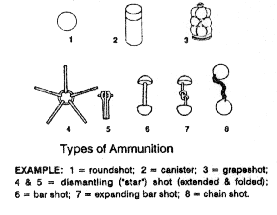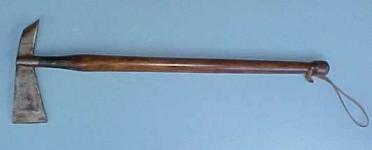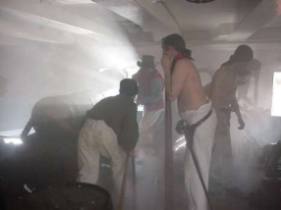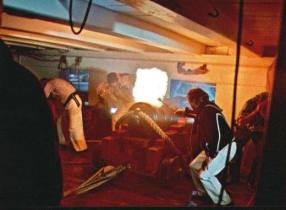Armament
Ships of this era were armed with two main weapons.
The long cannon and the carronade.

|
Mounted on a slide instead of a carriage the Carronade was a short
barreled weapon of limited range, typically half to a third the range of
a long gun. However its lighter weight allowed it to be mounted on a higher
deck. They were manufactured in the usual naval caliber's 12, 18, 24 and
32 pounders, with some smaller and heavier versions.
The Victory's
two 68 pounders are mounted on the fo'c'sle and could unleash a storm of
grapeshot across an enemies deck prior to boarding. At the battle of Trafalgar
Victory devastated one of the Bucentaures' gun decks when
it fired a 68 pound round shot and a keg of musket balls through the stern
gallery.
|
| A carronade mounted on a slide
|
.
|
.
As with the Carronades the Long Guns took their description from the
weight of round shot they fired, from 32 down to 6 pounders. The length
of the barrel varied as well, the 24 pounder was manufactured in 6 different
lengths, three of which were in common use.
The 32 pounder fired a shot just over 6 inches in diameter and with
a full charge of 10lb 11oz could make an extreme range of 2000 yards.
|
A 32 pounder Long Gun

|
Different
weights of powder were used, 'distance with one shot' was the full 10lb
11 oz charge, 'full with one shot was an 8lb charge, 'reduced with two
shot' was a 6lb charge ( to avoid bursting the gun), 'exercise and saluting'
was 6lb, and 'scaling and blank' which was fired to remove rust or attract
attention was 2lb 12oz. They were fired with a flintlock mechanism.
In the picture above grapeshot is in canvas bags on the gun carriage,
and the bar shot (for destroying the enemies rigging) on the deck. The
32 pounder guns were mounted on the lower gundeck about 6 feet (2 metres) above
the waterline. Lighter guns being mounted on succeding decks.
The recoil on these guns was controlled with ropes, a 32 pounder with a standard charge and restrained would recoil approximaletly 11 feet (3.3 metres) as it was fired. Unrestrained with a full proof charge (the charge used when the gun was proofed before being used in a ship) the 3 ton gun would recoil over 50 feet (15 metres).

|
Extreme ranges were seldom used in battle, a pistol shot or thirty
yards was more common. Distances were often described by reference to various
of the ships guns, so a pistol shot was 25 to 30 yards, a musket shot about
200 yards and a gunshot about 1000 yards. At such close ranges the power
of penetration of roundshot was impressive, at 30 yards an 18 pound shot
would penetrate four oak planks 32.5 inches thick (just under 1 meter thick),
hurling a shower of splinters up to thirty yards. At 300 yards range a
32 pounder firing grapeshot could penetrate 5 inches of fir planking and
4 of oak.
|
The pictures below show a cannon being operated by its gun crew.
Pictures reproduced with kind permission of the Historical Maritime Society.
Small Arms
In close quarter actions the fighting might require the men
to board or repel boarders from an enemy ship. For this purpose they were
armed with cutlasses, pistols, tomahawks, and pikes. The muskets were generally
used by the Marines.

The cutlass was a simple straight sword with a 28 inch blade,
an iron grip and guard, worn in a leather belt diagonally across the shoulder.
It was designed as a slashing and thrusting weapon and was not intended
for subtle fencing.
 picture kindly provided by John Haskell
picture kindly provided by John Haskell
The Tomahawk, officially known as a boarding axe, had a wedged
shaped head with a slightly curved blade and a sharp spike on the back,
it could be driven into the hull of an enemy vessel to make steps if there
were no hand holds.
The pike was about 7 and a half feet long and designed
to be used as a stab and move on weapon. The pikes were stowed on vertical
racks on the main deck around the masts.
The pistols came in long and short barreled versions, 9 inches
and 12 inches long, with a bore of 0.56 inches. The butt had a metal base (known as a skull crusher
butt cap)
so the pistol could be used as a club once fired. The muskets also came in two barrel lenghts, 3 feet 1 inch and
2 feet 2 inches, both could take a bayonet, and the effective range was
around 100 yards. Marine sharp shooters were placed in the rigging to fire
down on enemy ships, Nelson was killed by a French marine this way, firing from the
rigging of the Redoubtable.
Back to the top
Back to Broadside
|




